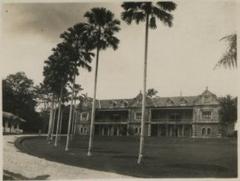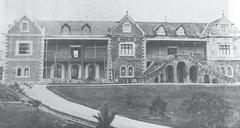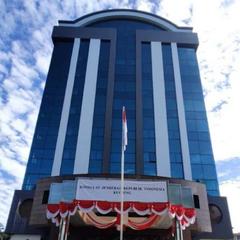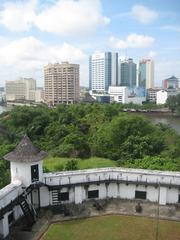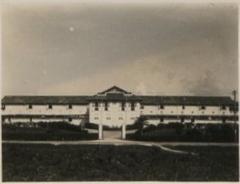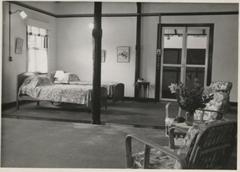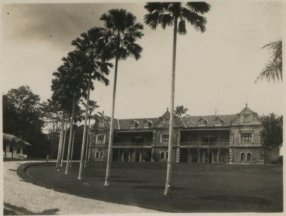
Visiting Hours, Tickets, and Historical Significance of Muzium Sarawak, Kuching
Date: 24/07/2024
Introduction
Nestled in the heart of Kuching, Malaysia, the Muzium Sarawak, also known as the Sarawak State Museum, stands as a beacon of cultural and historical preservation. Established in 1888 and officially opened to the public in 1891, it holds the distinction of being the oldest museum in Borneo (Sarawak Museum). Conceived by Charles Brooke, the second White Rajah of Sarawak, and the renowned naturalist Alfred Russel Wallace, the museum was founded to showcase the region’s rich natural history and diverse cultural heritage. Wallace’s extensive research and advocacy for preserving Borneo’s unique biodiversity significantly influenced the museum’s foundation (Sarawak Museum).
Over the years, the Sarawak State Museum has evolved from its original design, inspired by a Normandy town-house, to incorporate modern architectural elements and state-of-the-art exhibition spaces. This transformation culminated in the recent inauguration of the Borneo Cultures Museum in 2022, reflecting Sarawak’s rich traditional crafts and cultural heritage (Borneo Cultures Museum). The museum’s history is punctuated by significant events, such as its protection during the Japanese occupation in World War II, and its post-war development into a renowned research center and educational institution.
Visitors to the Sarawak State Museum can immerse themselves in a vast array of ethnographic artifacts, natural history specimens, and archaeological discoveries. The museum’s commitment to education is evident through its interactive programs, workshops, and annual publication of the Sarawak Museum Journal since 1910 (Sarawak Museum). With free admission and strategic location near other cultural attractions in Kuching, the Sarawak State Museum is an accessible and enriching destination for all who seek to explore the region’s history and heritage.
Table of Contents
- [Establishment and Early Years](#establishment-and-early-yearsestablishment-and-early-years)
- [Architectural Design and Modernization](#architectural-design-and-modernizationarchitectural-design-and-modernization)
- [Role During the Japanese Occupation](#role-during-the-japanese-occupationrole-during-the-japanese-occupation)
- [Post-War Developments](#post-war-developmentspost-war-developments)
- [Collections and Exhibits](#collections-and-exhibitscollections-and-exhibits)
- [Educational Programs and Workshops](#educational-programs-and-workshopseducational-programs-and-workshops)
- [Conservation Efforts](#conservation-effortsconservation-efforts)
- [Visiting Hours and Ticket Information](#visiting-hours-and-ticket-informationvisiting-hours-and-ticket-information)
- [Nearby Attractions](#nearby-attractionsnearby-attractions)
- [Future Prospects](#future-prospectsfuture-prospects)
- [FAQ](#faqfaq)
- [Conclusion](#conclusionconclusion)
- [Call to Action](#call-to-actioncall-to-action)
Establishment and Early Years
The Sarawak State Museum in Kuching, Malaysia, the oldest museum in Borneo, was established in 1888 and opened to the public in 1891. Founded by Charles Brooke, the second White Rajah of Sarawak, with significant influence from Alfred Russel Wallace, the museum was conceived to showcase the region’s rich natural history and diverse cultural heritage (Sarawak Museum).
Architectural Design and Modernization
The original museum building was designed in the style of a Normandy town-house, reflecting European architectural influences. This design choice was intended to create a sense of familiarity and prestige, aligning with the colonial aesthetics of the time. The building has undergone several expansions and renovations, including a significant extension in 1911 to accommodate the growing collection of artifacts. In recent years, the Sarawak State Museum has undergone significant modernization efforts. The construction of the Borneo Cultures Museum, a new five-story building adjacent to the original museum, was completed in 2022. This new facility is designed to reflect Sarawak’s unique traditional crafts and rich cultural heritage, featuring modern architectural elements and state-of-the-art exhibition spaces (Borneo Cultures Museum).
Role During the Japanese Occupation
During World War II, the Sarawak State Museum was under the administration of a Japanese officer who was sympathetic to the museum’s goals. This officer ensured the protection of the museum’s collections, which suffered minimal damage and looting during the occupation. This period was crucial in preserving the museum’s extensive collection of artifacts and natural history specimens (Sarawak Museum).
Post-War Developments
After the war, the museum continued to expand its collections and influence. In 1963, Sarawak gained independence through the formation of Malaysia, which further solidified the museum’s role as a cultural and educational institution. The museum’s reputation grew internationally, and it became a significant research center in Borneo, publishing the Sarawak Museum Journal annually since 1910 (Sarawak Museum).
Collections and Exhibits
The Sarawak State Museum houses an extensive collection of ethnographic artifacts, natural history specimens, and archaeological discoveries. The museum’s exhibits provide a comprehensive insight into the region’s past, showcasing the cultural artifacts and biodiversity of Borneo. Notable collections include traditional textiles, ceramics, marionettes, and a significant number of historical musical instruments (Sarawak State Museum).
Educational Programs and Workshops
The museum is also known for its educational programs and workshops, which aim to connect with younger audiences and educate them about the historical and cultural significance of Borneo. These initiatives include interactive displays, digital archives, and improved museum facilities, providing a more engaging and informative experience for visitors (Sarawak Museum).
Conservation Efforts
Sustainability in tourism is a key focus for the Sarawak State Museum. Efforts such as the use of energy-efficient lighting and climate control systems in the galleries not only preserve the artifacts but also align with eco-friendly tourism practices. The museum’s commitment to conservation extends to its role as a research center, contributing to the preservation of Borneo’s natural and cultural heritage (Sarawak Museum).
Visiting Hours and Ticket Information
The Sarawak State Museum is open to the public from Monday to Friday, 9:00 AM to 4:45 PM, and on weekends from 10:00 AM to 4:00 PM. The museum is closed on major public holidays, including Labour Day and Malaysia Day. Admission to the museum is free, making it an accessible destination for both local and international visitors. Tickets for special exhibitions and tours can be purchased online or at the museum entrance (Sarawak State Museum).
Nearby Attractions
Visitors to the Sarawak State Museum can also explore other nearby attractions in Kuching, such as the Kuching Waterfront, the Cat Museum, and the Sarawak Cultural Village. These sites offer additional insights into the rich cultural heritage and history of the region.
Future Prospects
Looking ahead, the Sarawak State Museum aims to continue its role as a leading cultural and educational institution in Borneo. The recent completion of the new Sarawak Museum Campus is expected to redefine the museum experience with state-of-the-art exhibition spaces and conservation facilities. This development indicates a shift towards incorporating modern amenities while preserving the site’s historical integrity (Sarawak Museum).
FAQ
What are the opening hours for Sarawak State Museum?
- The Sarawak State Museum is open from Monday to Friday, 9:00 AM to 4:45 PM, and on weekends from 10:00 AM to 4:00 PM.
How much are tickets to Sarawak State Museum?
- Admission to the museum is free, but tickets for special exhibitions and tours can be purchased online or at the museum entrance.
What are some nearby attractions?
- Nearby attractions include the Kuching Waterfront, the Cat Museum, and the Sarawak Cultural Village.
Conclusion
The Sarawak State Museum stands as a testament to the rich cultural and natural heritage of Borneo. Its history, from its establishment in the late 19th century to its recent modernization efforts, reflects its enduring significance as a center for education, research, and conservation. Visitors to the museum can expect a comprehensive and engaging experience, exploring the diverse and vibrant history of Sarawak (Sarawak Museum).
Call to Action
Stay updated with the latest news and events from the Sarawak State Museum by following us on social media or visiting our website. Download our mobile app for an enhanced museum experience and exclusive content.
